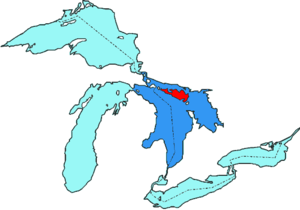Manitoulin
| Manitoulin | |
|---|---|
| Manitoulin (satellite photo) | |
| Waters | Lake Huron |
| Geographical location | 45 ° 46 ′ N , 82 ° 12 ′ W |
| surface | 2 766 km² |
| Residents | 10,603 (2001) 3.8 inhabitants / km² |
| main place | Little Current |
Manitoulin is an island in Lake Huron in the Canadian province of Ontario . With 2766 km² (a little more than the area of the Saarland ) it is the largest island in the world located in a lake ( inland lake island ). Together with some smaller islands, Manitoulin Island now forms the Manitoulin District . The island is connected to the mainland by a former railway bridge.
"Manitoulin" means "spirit island" in the language of the Anishinabe . Today's Odawa and Anishinabe call the island Odwa-minis, the island of Ottawa. In 2001 Manitoulin had 10,603 inhabitants, more than one in three was a member of the Anishinabe, the Potawatomi or the Odawa . For the Anishinabe, the island has always been sacred territory, where they buried their dead and prepared for visions. Today there are six Indian reservations: Aundeck, Omni Kaning, Sheguiandah, M'chigeeng, Shesigwaning and Wikwemikong, corresponding to the six First Nations, ie the Shesehgwaning, Sheguiandah, the Whitfish River, Zhiibaahaasing and the M'chigeeng First Nation and Wikwemikong.
The island consists mainly of dolomite and geologically belongs to the Niagara strata . There are 108 lakes, some of which contain small islands. At 104 km², Lake Manitou is the world's largest lake on an island in a lake. Manitoulin has three rivers, Kagawong , Manitou, and Mindemoya River , which are rich in salmon and trout.
history
Artifacts were found near Sheguiandah in 1954, showing that the island was inhabited 10,000 years ago.
The first European we know of who settled on the island was Father Joseph Poncet, a French Jesuit who set up a mission near Wikwemikong in 1648 . The Jesuits called the island "Isle de Ste. Marie ". Diseases brought in by visitors reduced the island's indigenous population. For reasons unknown, the Indians left the island by 1700. Oral tradition has it that when the island was left it was burned to purify it. It remained uninhabited until around 1825.
During the war from 1812 to 1814, Odawa, Ojibwe and Potawatomi again began to colonize the island after they had fled the United States. The Americans shelled the west of the island. Many Odawa, allied with the British, were unable to return and moved to Manitoulin, where their ancestors originally came from. In July 1818, 350 Odawa and Ojibwe negotiated with Canadian officials on Drummond Island - which Canada ceded to the United States in 1828. At the same time, white refugees who had been allied with Great Britain moved to the Bruce Peninsula . They decimated the wildlife and endangered the Indians who lived there. Sir Peregrine Maitland , Governor of Upper Canada , made Manitoulin a refuge for both the Michigan and the Bruce Peninsula Indians and promised them an eternal home.
His successor John Colborne induced the Odawa to accept more refugees, or whoever he would send to the island. Sir Francis Bond Head signed a treaty in 1836 that promised the entire island to the Indians. In 1837 the number of settlers was estimated at 268, in 1838 there were 307. In 1850 Waiebijewung was established, today's Little Current ; its residents were deported a few years later to the Aundeck Omni Kaning reserve, a few kilometers away.
Many Anishinabe came back with Father Jean-Baptiste Proulx from Michigan, where they had fled. This is how a community came into being in Wikwemikong . The island was ceded to the crown in 1836 and became an Indian reservation. Jean-Baptiste Proulx established a Catholic mission in 1838, which the Jesuits took over in 1845.
Manitowaning , founded in 1837, was the first European settlement on the island. On August 4, 1862, the island was contractually released for settlement by non-indigenous people, but Wikwemikong refused, so that it is the only reserve that has never been ceded to Canada. The eastern part of the island belongs to him. Every year in August there is a Powwow in Wikwemikong, with singing, dancing and traditional food in the foreground.
Web links
See also
Individual evidence
- ↑ Statistics Canada, 2001 ( Memento of September 16, 2005 in the Internet Archive )



